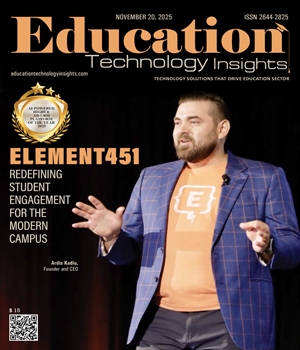THANK YOU FOR SUBSCRIBING
Be first to read the latest tech news, Industry Leader's Insights, and CIO interviews of medium and large enterprises exclusively from Education Technology Insights
Collaborative Tools to Support the Development of Transversal Skills
Diane Weatherup CMger, MCMI, MSc, Acting Head of Learning Academy at South Eastern Regional College
 Diane Weatherup CMger, MCMI, MSc, Acting Head of Learning Academy at South Eastern Regional College
Diane Weatherup CMger, MCMI, MSc, Acting Head of Learning Academy at South Eastern Regional CollegeWe are living through the 4th industrial revolution; Artificial Intelligence, robotics, and the Internet of Things are just some of the factors that will continue to transform our world at an incredible pace. The students we serve as educators are going into a world of work that they will navigate for 60 years, and we cannot predict with certainty what jobs will exist in the medium term, never mind 60 years from now.
Giving our students the skills they need to thrive and grow in such an unpredictable environment has never been more important.
To support this, South Eastern Regional College (SERC), based in Northern Ireland, has introduced a Project-based Learning curriculum with a particular focus on the development of transversal skills. Transversal skills are recognised by a wide range of government and educational stakeholders as skills that are not specifically related to a job or vocational area but cut across or ‘traverse’ different sectors and roles. Transversal skills help learners learn, work with others, solve problems, thrive in a digital world, and develop important personal attributes such as communication skills, perseverance, self-efficacy, and respect for diversity.
"Of course, TEL is a tool, not the solution, but we find such digital platforms create and support a dynamic and collaborative environment that works so well in a Project-based Learning curriculum. "
Project-based Learning (PBL) develops students’ transversal skills by offering real-world challenges that they try to solve collaboratively and from which solutions are developed, reviewed and implemented. It is important if students are to take the project seriously that their solutions are presented to and critiqued by an external audience, whether that be a local employer or a stakeholder. As the project briefs are tackled in groups, they learn how to work with others; as they try to find solutions, they discover what they don’t know and asking for support in those skills develops independent learning; most importantly, the mistakes they work through build resiliency. In this process, the teacher becomes a facilitator, questioning, clarifying, consolidating, and guiding. It is important for safety and resource practicalities that parameters are set around the brief, but the students must lead within these parameters. Indeed, our experience is that the solutions students come up with are often not anything teachers would even have considered.
As budgets tighten and students need to diversify, collaborative Technology Enhanced Learning (TEL) tools have become increasingly important to support Project-based Learning and Transversal Skills development. SERC is a Microsoft 365 Education licenced College, so students utilise MS Teams, OneNote and OneDrive for collaboration, but Google Apps for Education has similar functionality. It is key that students have seamless collaborative tools that meet individual and group preferences; some students in PBL groups meet with their cameras on in a virtual meeting space while others work on detailed prototype schematics in digital notebook OneNote. E-meetings have increased employer engagement by making it quicker and easier for them to meet teachers to create Project-based Learning briefs for real-world problems they have and for mentoring between student projects and employers to take place. Digital Whiteboards are available as MS and Google products, and they can be useful for collaboration, though Miro has great templates that support and encourage ideation, process thinking and project planning. Flip offers a safe space for students who want to present concepts through video and audio or to sell their product or concept solution. Canva now includes AI functionality and can easily build professional logos and branding for student product developments and student companies. Not only will TEL tools aid with Project-based Learning, but digital literacy itself is a key transversal skill, so getting your students to try a range of TEL tools will build their digital skills. Of course, sometimes, what we want to promote is face-to-face collaboration. Still, then many digital tools will become great ways to promote creative thinking, creativity, and record project planning and agreed actions. Even if students prefer to use pen and paper or post-its, any scanning app such as MS Lens can take photos of the hard copy and turn it into digital text. Of course, TEL is a tool, not the solution, but we find such digital platforms create and support a dynamic and collaborative environment that works so well in a Project-based Learning curriculum.
Read Also
Goldilocks Regulation
Beyond the Quiz: Redefining Competence in eLearning
Beyond Theory and Into Monday Morning: Enhancing Graduate Programs for Teachers
Safeguarding Students in the Age of Deepfakes: An Educational Imperative
Delivering Excellence in Education through Transformative School Leadership
Curriculum Innovation for Student Success and Institutional Growth

I agree We use cookies on this website to enhance your user experience. By clicking any link on this page you are giving your consent for us to set cookies. More info





















